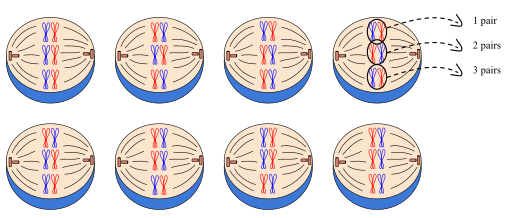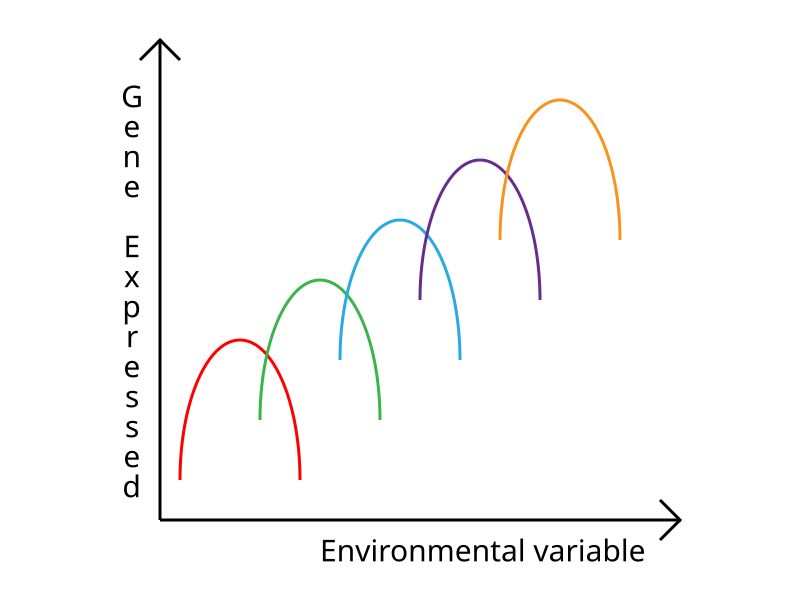OCR Specification focus:
‘Discuss how genetic and environmental factors contribute to phenotype, and how meiosis and random fusion of gametes generate genetic variation.’
Phenotypic variation refers to the observable differences among individuals of the same species, shaped by both genetic and environmental influences acting at molecular, cellular and organismal levels.
Genetic Sources of Phenotypic Variation
Genetic variation arises from differences in DNA sequences between individuals. These variations form the basis upon which natural selection and inheritance operate.
Mutations as a Source of Variation
Mutations introduce new alleles into a population by altering the nucleotide sequence of DNA.
Mutation: A permanent change in the DNA sequence that can affect gene function and phenotype.
Mutations may occur spontaneously during DNA replication or be induced by mutagens such as UV radiation or chemicals.
Point mutations alter a single nucleotide, which can change the amino acid sequence of a protein.
Insertion or deletion mutations may cause frameshift effects, altering downstream codons.
Some mutations are silent, causing no change in phenotype, while others may be beneficial, neutral, or harmful, depending on their impact on protein function.
Role of Meiosis in Generating Genetic Variation
Meiosis ensures that gametes (sperm and egg cells) contain unique combinations of alleles. This process introduces variation through two major mechanisms.
Crossing Over (Recombination)
During prophase I of meiosis, homologous chromosomes pair and exchange corresponding segments of DNA.

Independent assortment means each homologous pair orients randomly at metaphase I, so maternal and paternal chromosomes are assorted into gametes in many combinations. The diagram shows three homologous pairs and the resulting 2ⁿ combinations of gametes. The equation annotation is an accepted summary of the concept and remains within syllabus scope. Source.
Crossing Over: The exchange of genetic material between homologous chromosomes during meiosis I, producing new allele combinations.
This recombination increases genetic diversity by generating chromosomes with new combinations of maternal and paternal alleles.
Independent Assortment of Chromosomes
During metaphase I, homologous chromosome pairs align randomly along the equator of the cell. The orientation of each pair is independent of others. This leads to a large number of possible combinations of maternal and paternal chromosomes in gametes, greatly increasing genetic variation.
Random Fusion of Gametes
Fertilisation introduces another layer of variability. Each gamete carries a different set of alleles due to meiosis. When two gametes fuse at random, the resulting zygote inherits a unique genetic makeup.
Fertilisation: The random fusion of male and female gametes to form a diploid zygote, restoring the full chromosome number.
Because gamete fusion is random, the number of possible genetic combinations in offspring is enormous, contributing significantly to phenotypic diversity within populations.
Role of Gene Interactions
Phenotypic expression often depends on how different genes interact. For instance:
Epistasis occurs when one gene masks or modifies the expression of another.
Polygenic inheritance involves multiple genes contributing additively to a single trait, producing continuous variation.
Dominant and recessive relationships between alleles influence the expression of traits at each locus.
Environmental Sources of Phenotypic Variation
Phenotypic characteristics are not determined by genotype alone. Environmental factors profoundly influence gene expression and trait development.
Influence of Environmental Conditions
Environmental conditions such as temperature, light intensity, diet, toxins and disease exposure can modify phenotype.
In plants, light and nutrient availability affect growth rate, leaf size and chlorophyll content.
In animals, nutrition can determine size, body mass and reproductive capacity.
Temperature-dependent sex determination in reptiles is an example of environmental control of phenotype.
Interaction Between Genes and Environment
The relationship between genotype and environment is often described as gene–environment interaction.
The same genotype can produce different phenotypes under different conditions (known as phenotypic plasticity).

A reaction norm plots phenotype against an environmental gradient for one or more genotypes, illustrating how the same genotype can express different phenotypes across environments. This figure emphasises the concept rather than a specific organism. No extra syllabus-beyond content is required to interpret it. Source.
Phenotypic Plasticity: The ability of an organism to alter its phenotype in response to environmental changes.
Such plasticity is advantageous, allowing organisms to adapt to variable environments without requiring genetic change.
Types of Phenotypic Variation
Phenotypic variation can be categorised into discontinuous and continuous forms, based on the influence of genes and environment.
Discontinuous Variation
Discontinuous variation describes traits that fall into distinct categories, usually controlled by a single gene (monogenic inheritance).
Examples include:
Blood groups in humans (A, B, AB, O)
Flower colour in pea plants
Environmental factors have little or no influence on such traits. Individuals either possess or lack specific characteristics, with no intermediate forms.
Continuous Variation
Continuous variation shows a range of phenotypes between two extremes, with no distinct categories. It is typically polygenic, controlled by many genes with additive effects, and strongly influenced by environmental factors.
Examples include:
Human height
Body mass
Skin pigmentation
These traits display a normal distribution within a population, with most individuals near the mean and fewer at the extremes.
Importance of Phenotypic Variation in Evolution
Phenotypic variation provides the raw material for evolution. In populations, variation allows natural selection to favour individuals best adapted to environmental conditions. Beneficial genetic variants increase in frequency over generations, leading to evolutionary change.
Natural Selection: The process by which organisms with advantageous traits survive and reproduce more successfully, passing on those traits to offspring.
Without variation, all individuals would respond identically to environmental changes, making adaptation and long-term survival impossible.
Summary of Key Processes Generating Variation
Mutations introduce new alleles into a gene pool.
Crossing over and independent assortment during meiosis create new allele combinations.
Random fertilisation produces unique zygotes.
Environmental influences modify phenotypic outcomes.
Gene–environment interactions determine the range and adaptability of traits.
Together, these processes ensure that every organism is genetically and phenotypically unique, forming the foundation for biological diversity, evolution and adaptation.
FAQ
Mutations in non-coding regions, such as promoters or enhancers, can alter gene expression without changing the protein-coding sequence.
These mutations may affect how strongly, where, or when a gene is transcribed, leading to subtle phenotypic differences.
For example, a mutation in a regulatory sequence could increase or decrease the production of a protein, influencing traits like pigment intensity or growth rate.
Such regulatory mutations are important in evolution, as they provide variation without necessarily harming essential proteins.
Continuous variation results from polygenic inheritance, where many genes each contribute a small additive effect to a trait.
When multiple genes and environmental factors influence a trait, their combined effect produces a bell-shaped or normal distribution.
Most individuals have a mix of alleles that produce intermediate phenotypes, while extreme combinations are rarer.
This pattern is typical for traits like height or skin colour in humans.
Heritable variation arises from genetic differences, such as mutations or recombination, and can be passed on to offspring.
Non-heritable variation results from environmental influences or developmental conditions and cannot be inherited.
For example, muscle mass gained through training is non-heritable, whereas the genetic potential for muscle growth is heritable.
Understanding this distinction is crucial when studying evolution and artificial selection.
Epigenetic changes, such as DNA methylation or histone modification, alter how genes are expressed without changing the DNA sequence.
These modifications can be influenced by environmental factors like diet or stress and may activate or silence genes involved in development.
In some cases, epigenetic states can be passed to offspring, contributing to short-term heritable phenotypic variation.
Epigenetics helps explain how identical genotypes can display different phenotypes under varying conditions.
Each gamete formed during meiosis carries a unique allele combination due to crossing over and independent assortment.
When fertilisation occurs, any sperm can fuse with any egg, producing an enormous number of possible genetic combinations.
For humans, with 23 chromosome pairs, this means over 70 trillion potential zygote combinations (ignoring crossing over).
This randomness ensures each offspring has a unique genetic identity, enhancing variation within populations.
Practice Questions
Question 1 (2 marks)
Explain how independent assortment during meiosis contributes to genetic variation in a species.
Mark scheme:
(1 mark) Random orientation of homologous chromosomes at the equator during metaphase I.
(1 mark) Results in different combinations of maternal and paternal chromosomes (alleles) in gametes.
Question 2 (5 marks)
Discuss how both genetic and environmental factors contribute to phenotypic variation within a population.
Mark scheme:
(1 mark) Genetic variation arises from mutations, crossing over and independent assortment during meiosis.
(1 mark) Random fertilisation of gametes increases variation in offspring.
(1 mark) Environmental factors such as temperature, light, diet or disease can influence gene expression and phenotype.
(1 mark) The same genotype can produce different phenotypes under different environmental conditions (phenotypic plasticity).
(1 mark) Combined genetic and environmental influences result in a continuous range of phenotypes within a population.

